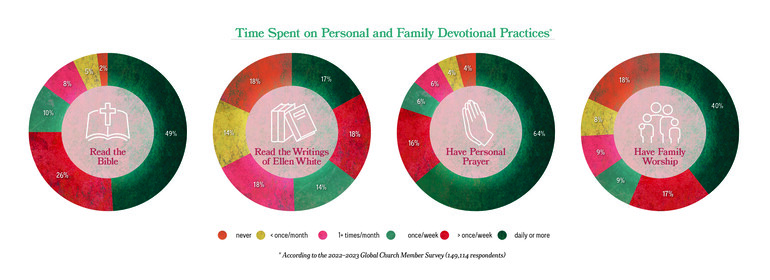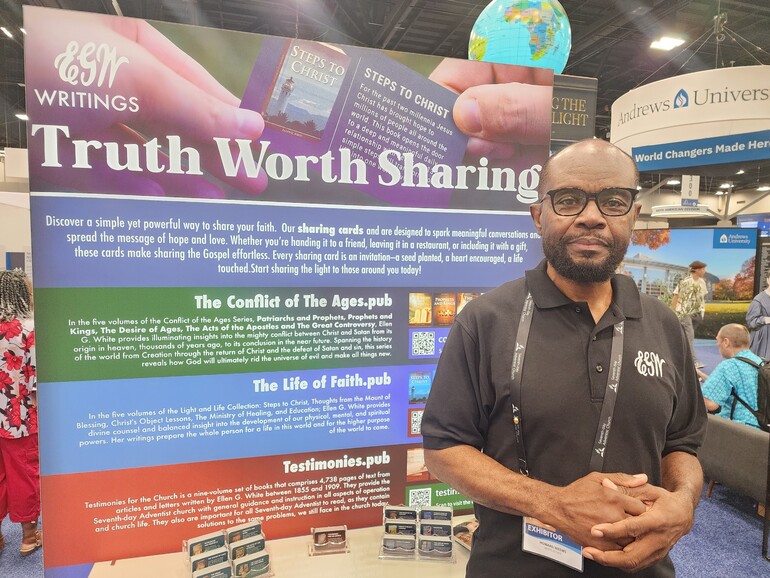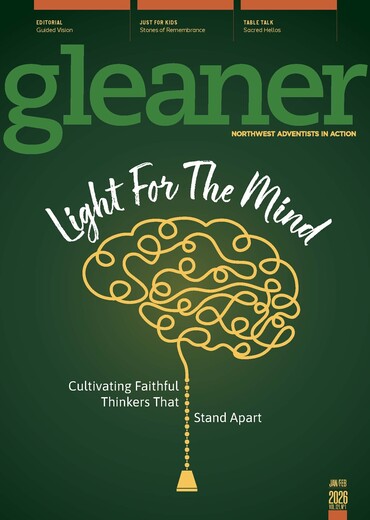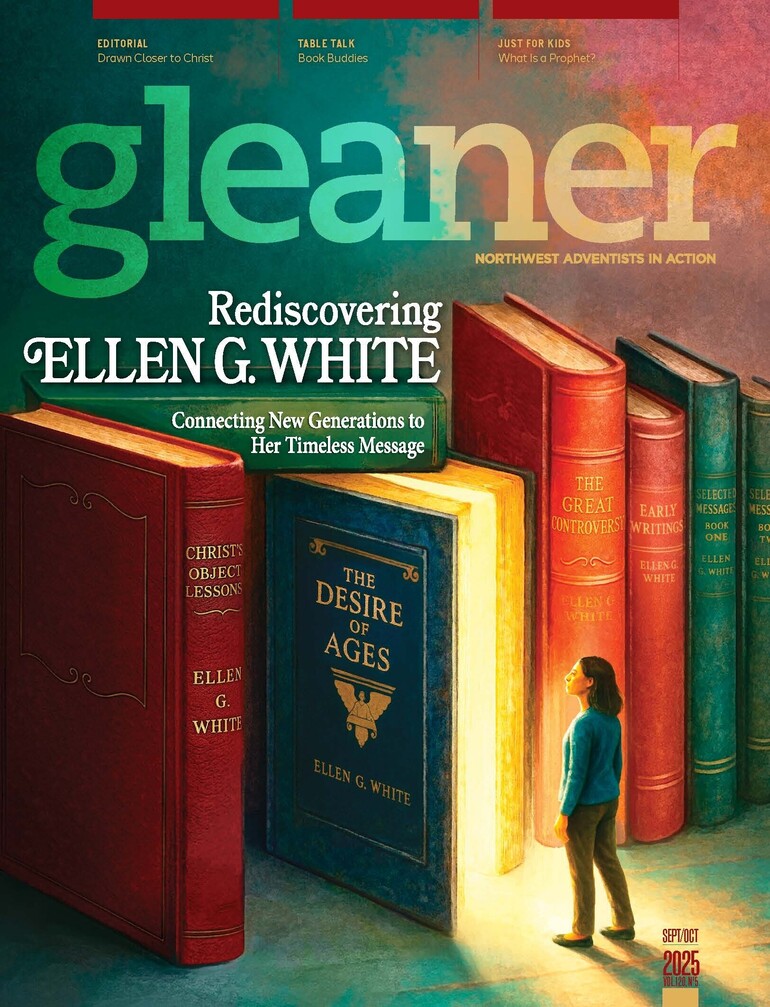Think back to the last time you opened a book by Ellen G. White — a prophet called by God, a visionary author and a spiritual leader whose mission was to point people to Jesus and prepare them to live faithfully in mission and ministry on the journey to heaven.
Was it yesterday? Today? Perhaps you read her writings a couple of times a week for devotional inspiration or Bible study insight. Or maybe it’s been a while and you’ve forgotten the impact of her inspired words. You might even have had questions, doubts or experiences that caused you to pause — or even stop — reading altogether.
Among Adventists worldwide, personal and family devotional reading habits vary widely.
According to the 2022–2023 Global Church Member Survey, 49% of respondents read the Bible daily and another 36% read it weekly. In contrast, only 17% read Ellen White’s writings daily, and 32% read weekly. Nearly half engage with her work at least once a week, but 18% say they never read her writings. Family worship patterns follow a similar trend.
The Spirit of Prophecy — Ellen White’s remarkable and extensive collection of writings — remains a cornerstone of Adventist identity and mission worldwide. Yet for all her contributions, one question remains: How do we position her work for continued relevance and reading among emerging generations?
“We want our members to gain the blessing of the insights from The Spirit of Prophecy,” said David Trim, General Conference Archives, Statistics and Research director, in a presentation at the 62nd General Conference Session.
While surveys show varied engagement with Ellen White’s writings, behind each data point is a personal story. Let’s explore the reading journeys — past and present — that continue to shape spiritual growth.

David Trim, General Conference Office of Archives, Statistics, and Research director, presents data behind the I Will Go strategic plan at the 62nd GC Session on Friday, July 11, 2025. This data included reports from the 2022-2023 Global Church Member Survey
Our Reading Journey
Depending on your reading journey, some readers may feel unsure about how to approach Ellen White’s writings — especially when some counsel was written for specific situations, while other insights speak to timeless principles.
Adventist pioneers, pastors, scholars and members have long read Ellen White with reverence, sometimes to the point of absolutism. Yet Ellen White consistently pointed people back to a grace-filled, Bible-centered faith.
Your perspective and any biases you may carry have likely been shaped by where and how you first encountered her.
Some readers have stepped back with questions; others have returned with curiosity. No matter where you are, the invitation to grow remains.
Recognizing your biases is just the beginning. The real question is whether you’re willing to take the next step — intentionally engaging with Ellen White’s writings for your own spiritual growth. No symposium, surveys or sermons — not even this article — can make that choice for you.
Countless Adventists have made that decision for themselves, opening their Bibles and The Spirit of Prophecy and finding their lives transformed.
The evidence is both anecdotal and measurable. In stories, surveys and personal testimonies, people who engage with scripture and The Spirit of Prophecy often describe deeper spiritual growth.
Together, these voices and numbers reveal a compelling picture of faith in action.

Shaping Spiritual Growth
One of the books that inspired this feature is What Ellen White Has Meant to Me — a collection of personal essays compiled by Herbert Douglass. First published in 1972, this volume may still be found in Adventist homes, churches or school libraries. It's now also available as an e-book through Ellen G. White Estate.
In its pages, theologians, evangelists, missionaries, professors and spiritual leaders share how Ellen White’s writings shaped their spiritual journeys. Many first encountered her books as teenagers, and the influence stayed with them for a lifetime.
One such reader was Richard Hammill, who converted to Adventism in college and found deep inspiration in Christ’s Object Lessons. In the 1930s, he began pastoral ministry in Washington Conference with little formal mentoring.
“Feeling inadequate, I again turned to the writings of Ellen White for special help, especially Gospel Workers and Testimonies to Ministers,” Hammill said of his early career days. “Her counsel has lifted a weary spirit.”
Eager to grow, he used his very first Christmas bonus to purchase the full Testimonies for the Church set.
“Composed as they are with personal testimonies to individuals and to leaders,” he said, “they helped me to see men and women striving, failing, rising again, giving, living their lives in an effort to advance the cause of the kingdom.”
For Hammill — who later became the second president of Andrews University — the writings became “not only an instrument of grace but the voice of God speaking to my soul [… to …] help me grow as a stable, steadfast, Seventh-day Adventist Christian.”
Charles D. Brooks, longtime evangelist and a General Conference field secretary, had a different journey. For him, reading Ellen White also meant wrestling with context and interpretation.
“You are probably wondering whether it has always been so simple for me to believe in [Ellen] White and her writings. The answer is No!” Brooks said.
He struggled to reconcile certain “isolated and misunderstood” passages of Testimonies, vol. 9, that seemed to convey racist overtones.
One day, his father-in-law introduced him to The Southern Work, which challenges believers to all stand equal in Jesus Christ. That book brought clarity and reassurance, and it helped anchor his understanding of both context and mission.
“I have thought many times how happy I am that I had read The Great Controversy and The Desire of Ages first,” Brooks said. “Once faith and love get their hooks into you, you cannot dislodge them easily.”
Across generations, church leaders have often faced leadership decisions without a clear roadmap. In those moments of uncertainty, they turned to prayer, scripture and the inspired counsel of Ellen White. Time and again, they saw God’s guidance unfold — offering just the right words at just the right moment.
Recognizing the Generational Gap
Global Church Member Survey data reveals an important reality: While nearly half of Adventists engage with Ellen White’s writings weekly, a significant portion never read them at all. This gap reflects more than just personal preference and highlights a growing generational distance.
After Ellen White’s death in 1915, each generation has moved one step further from Ellen White — not just in years, but in cultural assumptions, reading habits and how we relate to spiritual authority, Douglass noted.
Each contributor to What Ellen White Has Meant to Me made a deliberate personal choice to engage with her writings. They discovered their own steps to Christ, a framework for whole-person living, guidance for leadership and insights into God’s plans for the future.
Over time, however, generational distance — along with disinterest and even spiritual wounding from the rigid misuse of her writings — has widened. Words originally intended to offer grace and point people to Jesus have at times been used in ways that left listeners feeling inadequate, burdened or judged.
This concern extends beyond North America — it’s a global reality. Young people in India, for example, do believe in the prophetic ministry of Ellen White, yet they don’t read her books.
“Our young people have not really gone into a personal study to purposefully understand what their pastors or teachers have taught them,” said Koberson Langhu, from Spicer Adventist University, who joined the Ellen White exhibit team at the 62nd GC Session.
“When you don’t read the Bible, you also forget about Ellen White,” he added. “No matter our age, we need to understand our beliefs in our heads and our hearts.”

Koberson Langhu from Spicer Adventist University
Measured Impact
What difference does regular reading of Ellen White’s writings make in the spiritual lives of Adventists?
Andrews University Institute of Church Ministry conducted a major church growth survey in 1980 that remains as one of the most distinctive efforts to explore the spiritual benefits of reading Ellen White’s writings.
Among 8,200 Adventists surveyed across 193 churches in North American Division, 2,848 were regular readers and 5,375 were not.
Findings reported in Ministry magazine shared several striking conclusions. Readers of Ellen White’s books were more likely to report a stronger relationship with Jesus Christ, greater assurance of salvation and a clearer understanding of their spiritual gifts. They also felt more confident in their ability to witness and share their faith.
Decades later, the question of engagement remains. Research shows younger Adventists, especially, wrestle with this.
In a 2017 doctoral dissertation, Bobby J. Boles, pastor and researcher, reviewed findings from the ValueGenesis studies conducted in 1990, 2000 and 2010. He noted a troubling trend: Confidence in Ellen White’s writings among young Adventists had declined from 54% to 45% over two decades — a marked contrast to patterns seen among adults.
This led him to pose a key question for today’s church: Are young people rejecting Ellen White or are they rejecting how she has been portrayed to them?
Becky Meharry, North Pacific Union elementary education director, sees the importance of those early portrayals firsthand. Stories about Ellen White are included in the elementary reading curriculum, but how children perceive her, she noted, is often shaped by the attitudes of their teachers and parents.
For many young Adventists, their first sustained exposure to Ellen White’s writings comes through assigned readings in academy Bible classes or Pathfinder study guides — moments that can either nurture or dampen their curiosity.
Relational Rediscovery
Where does rediscovery begin? For many, the most meaningful entry point isn’t with doctrine, prophecy or obligation, but by getting to know Ellen White as a person.
Starting points vary — biography, devotionals or apologetics — depending on the reader’s interests, needs and season of life.
Whether starting for the first time or returning anew, a short devotional work like Steps to Christ or a book such as Understanding Ellen White — a 2015 collection of essays compiled by Merlin D. Burt, Ellen G. White Estate director — offers a natural entry point.
Jud Lake’s Ellen White Under Fire gives a readable overview of the challenges that have emerged over the years and provides a well-researched, approachable apologetics perspective on The Spirit of Prophecy.
Perhaps the most powerful way to begin is through a relational connection between an established and a new reader. Literature is often an entry point for new believers, and this new beginning needs a solid relational foundation for asking questions and dialoging.
“We put her up on a pedestal sometimes, but she had to grow and progress too,” said Howard Weems, Oakwood University Ellen G. White Resource Center director. “It helps to have a relationship with a person before giving them literature of any kind because they will be more open to reading versus being a skeptic.”
Once a relationship with Ellen White as an author and prophet begins, it’s often simple, practical truths that keep readers coming back.
“I found throughout my pastoral ministry, often at academy church campuses, that young people are open to reading materials that will help them understand their purpose in life,” said Kevin Wilfley, recently retired Upper Columbia Academy Church pastor.
Rediscovery isn’t just about reading — it’s about reconnecting with the heart behind the words.

Howard Weems from Oakwood University
Modern Day Relevance
While research reveals big-picture trends, it’s often the personal stories — moments of curiosity, discovery and honest questions — that connect most deeply and reveal Ellen White’s continuing relevance with modern readers.
Take the story of Rob Folkenberg, young adult church planter who, at the time of the following story, served in Squamish, British Columbia.
Serving at the time in what’s known as Canada’s “least religious community,” Folkenberg found himself immersed in a post-Christian, postmodern culture. For the first time in his life, he decided to read The Great Controversy, Ellen White’s magnum opus, cover to cover.
He approached the book through two lenses: as a millennial and through the eyes of his spiritually diverse community.
“As I read, I was surprised by how much it drew me in,” Folkenberg said. “The reading began to influence how I interpreted news items and personal struggles. I opened the book a cautious promoter. Honestly, I closed the book a fan.”
While many themes spoke to him, Folkenberg also wrestled with how the book might be received in a post-Christian culture. His reflections led to firm convictions about how The Great Controversy should — and shouldn’t — be shared today.
“The Great Controversy was not written for postmodern readers,” he said, “and so it is very likely to repel people who open it with a critical eye.”
He believes mass-mailing the book in secular contexts risks disrespecting the message, the author and potential readers. Instead, The Great Controversy and other titles need to be shared thoughtfully and relationally, so messages can be truly received by spiritually curious people. Read Folkenberg’s full case study at nwadvent.st/120-5-FT-42.
A Global Vision
Beyond generational concerns is another key issue: language accessibility.
When church leaders interact with international and unreached people groups, they will often point out that Ellen White’s books are not available in their language.
Recognizing the enduring power of her message, the church has launched an ambitious Sharing the Gift of Light global initiative to bring her works to new readers around the world.
In the next five years, 83 of Ellen White’s books will be translated from English into six major languages: Chinese, French, Portuguese, Russian, Spanish and Swahili. These translations will combine the use of a specially trained AI tool with careful human editing. The project will happen in phases, beginning with 16 foundational titles that include beloved classics like Steps to Christ, The Desire of Ages and The Great Controversy.
Additional efforts are underway to translate 35 additional titles into nine secondary languages — including German, Hindi, Korean, Tagalog and more — expanding access across diverse cultures and regions. Even further, Steps to Christ, The Great Controversy and The Desire of Ages will be made available in as many as 352 mission-focused languages, reflecting a deep desire to meet people where they are, in their own tongue.
An Invitation to Rediscover
How might you begin or renew your own journey of discovery with Ellen White’s writings? From the voices of history and reflections of today, two themes emerge clearly: the personal choice to engage as a reader and the need to find the right tools to navigate the engagement.
Ellen White’s writings are invitations to grow deeper in Christ today. Her voice may come through a printed book, a digital page, a podcast or a shared quote, but its power lies in how it points us toward scripture, strengthens our walk with God and speaks to the challenges of our time.
But this rediscovery was never meant to stand on its own. Ellen White consistently urged believers to anchor their faith in the Bible. Her writings are most meaningful when read alongside scripture — not as a replacement, but as a companion that helps us hear God’s voice more clearly.
The invitation isn’t to read every book or agree with every word. It’s to engage — prayerfully, thoughtfully and with the Holy Spirit’s leading.
Whether you're just starting, returning with fresh questions or unsure what you think, you're not alone on this journey. Ellen White’s writings were never meant to be a burden. They were meant to build up believers, encourage seekers and help us follow Jesus more closely — always through the lens of God’s word.
Perhaps the rediscovery starts now — with your story next.










